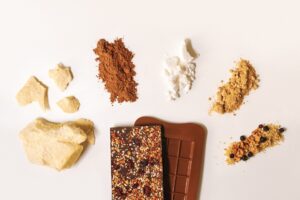
Unravelling the Stories of Couverture and Compound Chocolate
Chocolate, with its rich history spanning centuries, has evolved into a beloved indulgence enjoyed worldwide.
Within this journey, two significant milestones stand out: the emergence of couverture chocolate and compound chocolate.
Let’s delve into the fascinating histories of these chocolate varieties, tracing their origins and understanding their impact on the world of confectionery.
The Tale of Couverture Chocolate: Where Tradition Meets Excellence
The story of couverture chocolate begins centuries ago, in the heart of Europe, where master chocolatiers sought to create the epitome of chocolate luxury.
The term “couverture” itself, derived from French, translates to “covering,” reflecting its primary use in enrobing confections and pastries.
Historically, couverture chocolate distinguished itself through its superior quality and craftsmanship. Chocolatiers carefully selected premium cocoa beans and skilfully processed them to preserve the delicate flavours and aromas.
With its high cocoa butter content, couverture chocolate boasted a smooth texture and a glossy finish, ideal for moulding intricate shapes and creating exquisite decorations.
Over time, couverture chocolate became synonymous with artisanal excellence, gracing the shelves of prestigious chocolatiers and earning accolades from connoisseurs worldwide.
Today, it remains the go-to choice for professionals seeking unparalleled taste and texture in their creations, embodying centuries of tradition and dedication to the art of chocolate making.

The Evolution of Compound Chocolate: Innovation in Convenience
In contrast to the centuries-old tradition of chocolate, the history of compound chocolate is a more recent tale, born out of necessity and innovation in the modern age of confectionery.
As demand for chocolate products surged in the 20th century, manufacturers faced the challenge of meeting consumer expectations while balancing cost and convenience. Compound chocolate emerged as a solution, offering a blend of cocoa powder, sweeteners, and vegetable fats instead of cocoa butter.
This innovative formulation provided several advantages. Compound chocolate possessed greater stability, allowing it to withstand variations in temperature without melting or blooming.
Its lower cost made it accessible to a broader audience, paving the way for mass-produced chocolate treats enjoyed by millions around the world.
While compound chocolate may lack the nuanced flavours and artisanal appeal of couverture, its convenience and versatility have cemented its place in the modern confectionery landscape.
From chocolate bars to candy coatings, compound chocolate continues to play a vital role in satisfying our sweet cravings and fuelling our culinary creativity.


Thank you for providing such an informative article. Your content is greatly appreciated; we value the knowledge and insights you shared.
Thank You for your valuable feedback